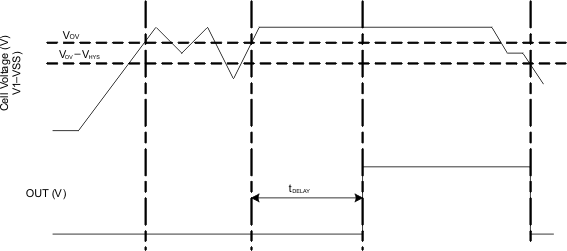SLUSAS0E December 2011 – April 2021 BQ2946
PRODUCTION DATA
- 1 Features
- 2 Applications
- 3 Description
- 4 Revision History
- 5 Device Options
- 6 Pin Configuration and Functions
- 7 Specifications
- 8 Detailed Description
- 9 Layout
- 10Device and Documentation Support
Package Options
Mechanical Data (Package|Pins)
- DRV|6
Thermal pad, mechanical data (Package|Pins)
- DRV|6
Orderable Information
8.3 Feature Description
The method of overvoltage detection is comparing the cell voltage to an OVP threshold voltage VOV. Once the cell voltage exceeds the programmed fixed value VOV, the delay timer circuit is activated. This delay (tDELAY) is fixed for 4 seconds for the BQ294602 device. When these conditions are satisfied, the OUT terminal is transitioned to a high level. This output (OUT) is released to a low condition if the cell input (V1) is below the OVP threshold minus the VHYS.
 Figure 8-1 Timing for Overvoltage Sensing
Figure 8-1 Timing for Overvoltage Sensing